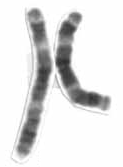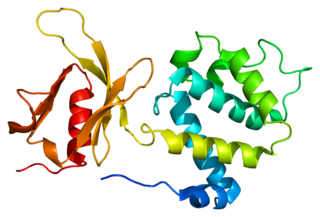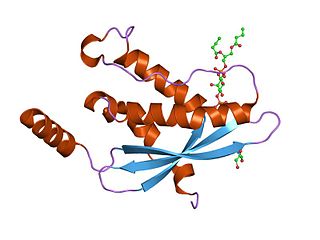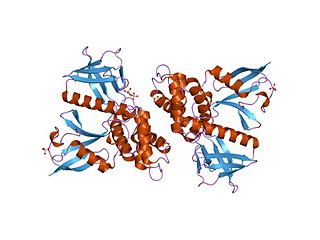Related Research Articles

Chromosome 3 is one of the 23 pairs of chromosomes in humans. People normally have two copies of this chromosome. Chromosome 3 spans almost 200 million base pairs and represents about 6.5 percent of the total DNA in cells.

Chromosome 10 is one of the 23 pairs of chromosomes in humans. People normally have two copies of this chromosome. Chromosome 10 spans about 133 million base pairs and represents between 4 and 4.5 percent of the total DNA in cells.

Merlin is a cytoskeletal protein. In humans, it is a tumor suppressor protein involved in neurofibromatosis type II. Sequence data reveal its similarity to the ERM protein family.
Talin is a high-molecular-weight cytoskeletal protein concentrated at regions of cell–substratum contact and, in lymphocytes, at cell–cell contacts. Discovered in 1983 by Keith Burridge and colleagues, talin is a ubiquitous cytosolic protein that is found in high concentrations in focal adhesions. It is capable of linking integrins to the actin cytoskeleton either directly or indirectly by interacting with vinculin and α-actinin.

Myosin X, also known as MYO10, is a protein that in humans is encoded by the MYO10 gene.

FERM, RhoGEF and pleckstrin domain-containing protein 1 is a protein that in humans is encoded by the FARP1 gene.

FERM domain-containing protein 7 is a protein that in humans is encoded by the FRMD7 gene.

Talin-1 is a protein that in humans is encoded by the TLN1 gene. Talin-1 is ubiquitously expressed, and is localized to costamere structures in cardiac and skeletal muscle cells, and to focal adhesions in smooth muscle and non-muscle cells. Talin-1 functions to mediate cell-cell adhesion via the linkage of integrins to the actin cytoskeleton and in the activation of integrins. Altered expression of talin-1 has been observed in patients with heart failure, however no mutations in TLN1 have been linked with specific diseases.

FERM domain-containing protein 6 is a protein that in humans is encoded by the FRMD6 gene.

FERM, RhoGEF and pleckstrin domain-containing protein 2 is a protein that in humans is encoded by the FARP2 gene.

The ERM protein family consists of three closely related proteins, ezrin, radixin and moesin. The three paralogs, ezrin, radixin and moesin, are present in vertebrates, whereas other species have only one ERM gene. Therefore, in vertebrates these paralogs likely arose by gene duplication.

Sorting nexins are a large group of proteins that are localized in the cytoplasm and have the potential for membrane association either through their lipid-binding PX domain or through protein–protein interactions with membrane-associated protein complexes Some members of this family have been shown to facilitate protein sorting.

Fermitin family homolog 3) (FERMT3), also known as kindlin-3 (KIND3), MIG2-like protein (MIG2B), or unc-112-related protein 2 (URP2) is a protein that in humans is encoded by the FERMT3 gene. The kindlin family of proteins, member of the B4.1 superfamily, comprises three conserved protein homologues, kindlin 1, 2, and 3. They each contain a bipartite FERM domain comprising four subdomains F0, F1, F2, and F3 that show homology with the FERM head (H) domain of the cytoskeletal Talin protein. Kindlins have been linked to Kindler syndrome, leukocyte adhesion deficiency, cancer and other acquired human diseases. They are essential in the organisation of focal adhesions that mediate cell-extracellular matrix junctions and are involved in other cellular compartments that control cell-cell contacts and nucleus functioning. Therefore, they are responsible for cell to cell crosstalk via cell-cell contacts and integrin mediated cell adhesion through focal adhesion proteins and as specialised adhesion structures of hematopoietic cells they are also present in podosome's F actin surrounding ring structure. Isoform 2 may act as a repressor of NF-kappa-B and apoptosis

In molecular biology, the FERM domain is a widespread protein module involved in localising proteins to the plasma membrane. FERM domains are found in a number of cytoskeletal-associated proteins that associate with various proteins at the interface between the plasma membrane and the cytoskeleton. The FERM domain is located at the N terminus in the majority of proteins in which it is found.

Coiled coil domain containing protein 120 (CCDC120), also known as JM11 protein, is a protein that, in humans, is encoded by the CCDC120 gene. The function of CCDC120 has not been formally identified but structural components, conservation, and interactions can be identified computationally.

FERM Domain Containing 4A is a gene, located on human Chromosome 10 at 10p13, that encodes FERM Domain Containing Protein 4A.

FERM and PDZ domain containing 3 is a protein that in humans is encoded by the FRMPD3 gene.

FERM and PDZ domain containing 4 is a protein that in humans is encoded by the FRMPD4 gene.

FERM domain containing 4B is a protein that in humans is encoded by the FRMD4B gene.
FRMD4B is a gene which codes for FERM Domain Containing 4B, a scaffolding protein. It is found at chromosome 3p14.1.
References
- ↑ "FRMD4B FERM domain containing 4B [ Homo sapiens (human) ]". NCBI. Retrieved 9 May 2013.